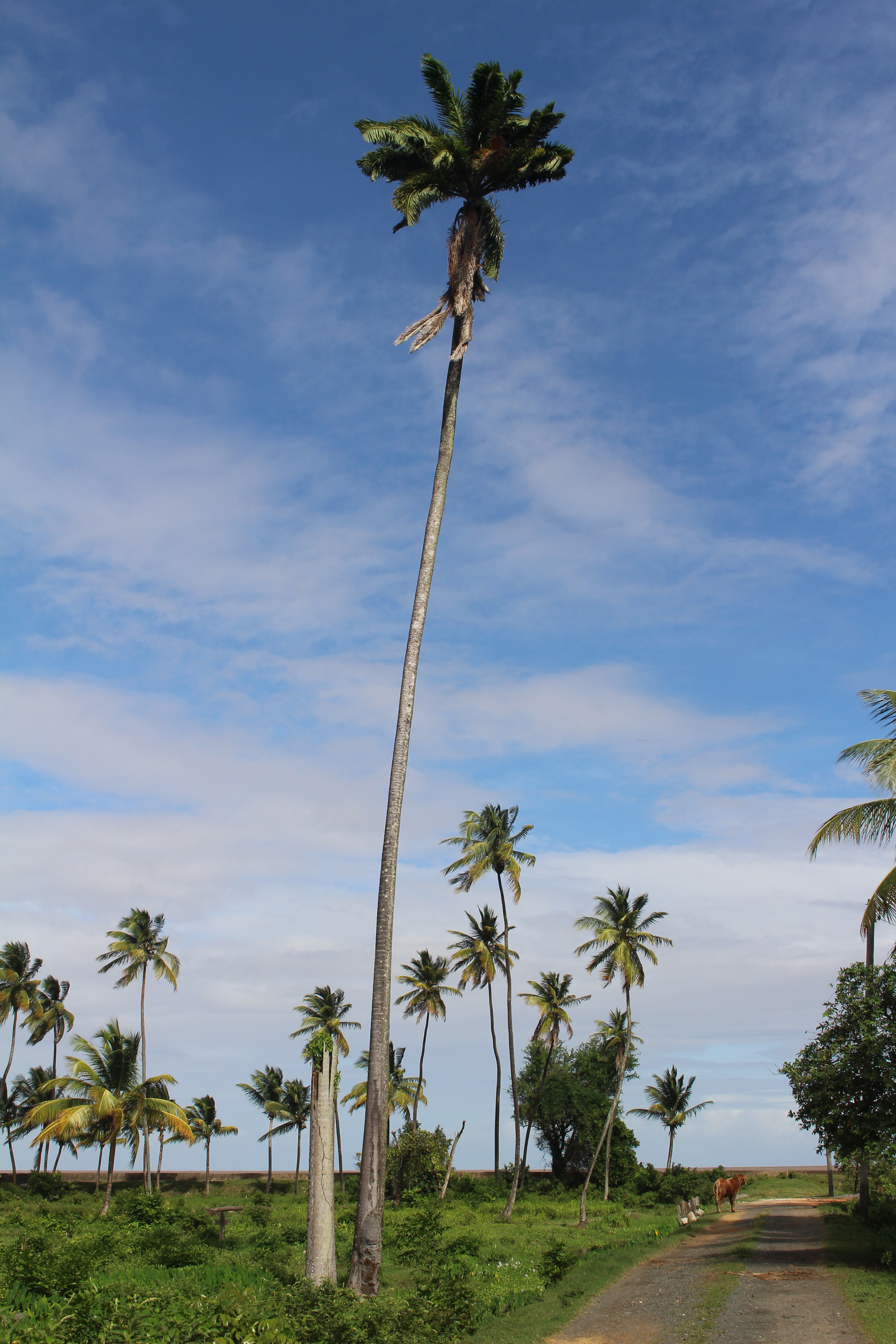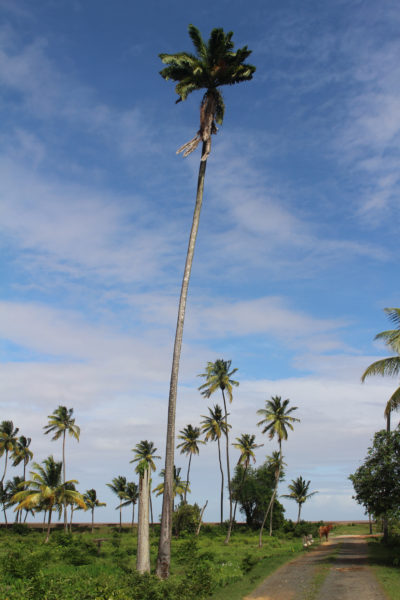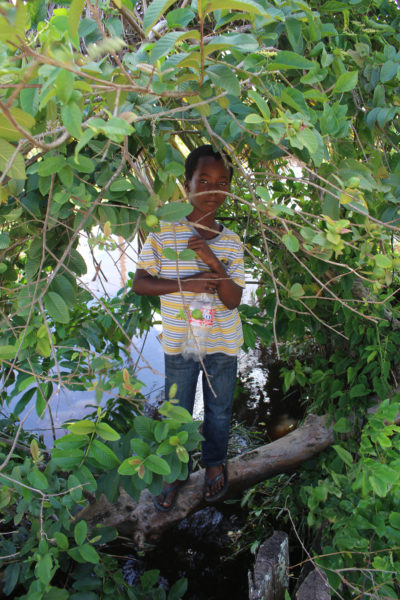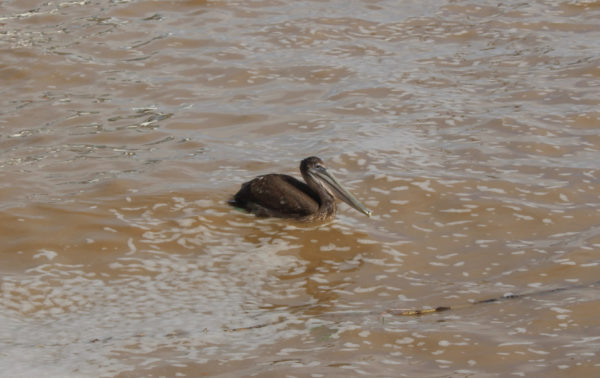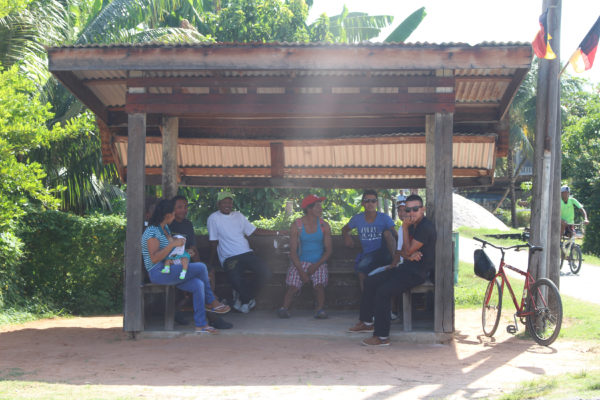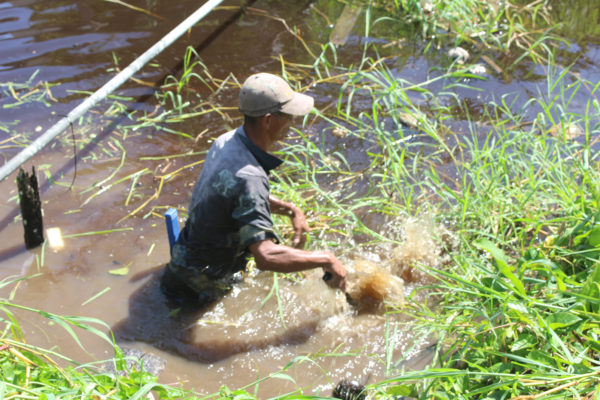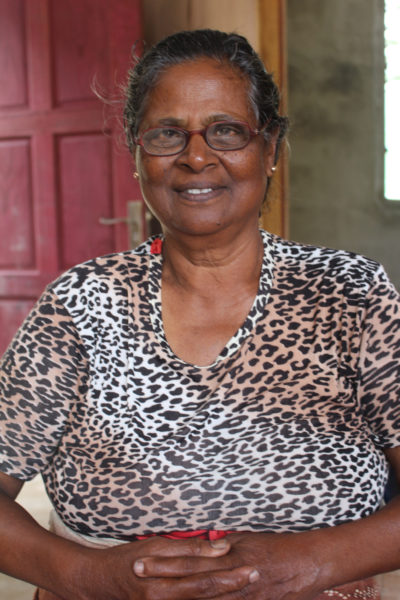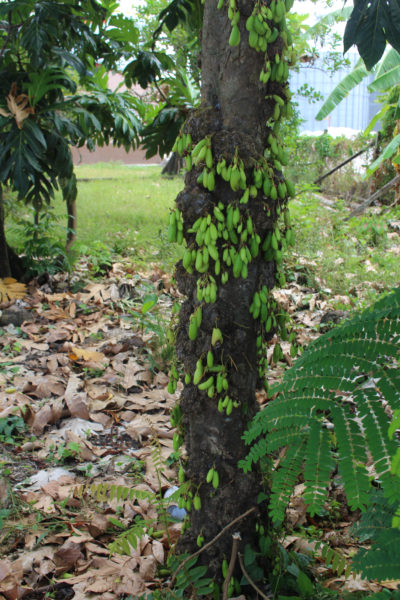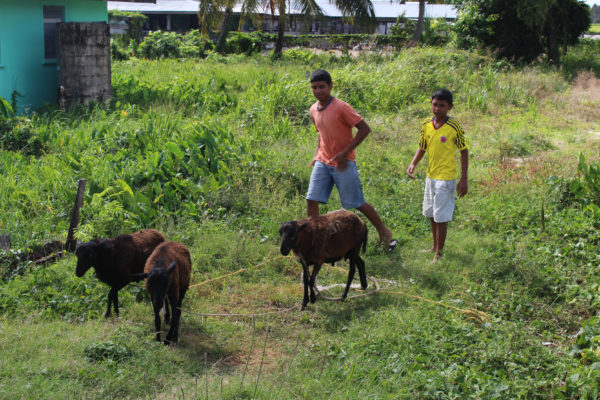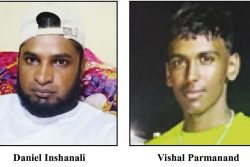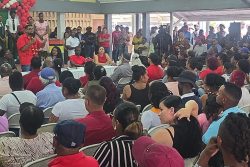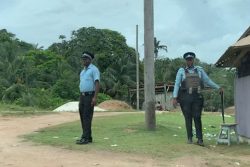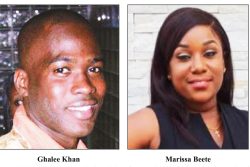Golden Fleece on the Essequibo Coast is situated 13 miles north of Supenaam and is home to approximately 700 persons. The village fits snugly between Zorg and Perseverance.
Golden Fleece is one of the cleanest villages in Guyana. Garbage is unlikely to be seen. Drains are kept clear of weeds so the water runs freely through and throughout the village lawns are kept short. Colourful flowers hang over fences and there are fruit trees in almost every yard: mango, bilimbi, cherry, sapodilla, guava and katahar to mention a few. Animals graze at the corners of streets but the roads remain clear of dung and what adds grace to the already beautiful scenery, are the ducks gliding on the water. Golden Fleece is a scene out of a storybook.
The World Beyond Georgetown visited on a weekend, so children could be seen getting their chores done, while others were at lessons. Bhajans escape through the doors of the Golden Fleece Vishwa Jhoti Mandir.
Sasenaraine Seer was seated chatting with his wife and awaiting the arrival of his students to his bottom-house lessons when we caught up with him. Sixty-four-year-old Sir Seer, as he is called, is a retired head teacher of the Aurora Primary School. He offers lessons to children preparing to write the National Grade Six Assessment.
The village, Seer said, was rumoured to have once been a sugar plantation under the Dutch. Golden Fleece is said to be divided into two: Dutch Quarter and Sand Quarter. No one seems to know why they are called quarters when the village is only divided in half. It is believed that the Dutch lived in Dutch Quarter, while the labourers lived in the Sand Quarter. Some of the streets are called; Truck Line Dam, Sugar Dam or School Dam and Market Dam.
“I was born in a logie. I learnt that the European manager was involved in gambling and as a result sugar production began to decline. The then queen requested a sample of the soil and the administration not wanting to go through with sugar anymore took samples from the sea instead and as the soil was proven to be too high in acidity, the sugar cane production was abandoned. The estate was sold to C R Chan (a Chinese man) who divided it between his two sons (Osborne Chan and Foster Chan). They lived in European-style houses that had slate at the top and were built mostly by greenheart and pitch pine,” Seer said. The lands were later leased to the East Indians for planting rice, most of whom eventually bought them.
There two schools in Golden Fleece: Fisher Nursery in the Sand Quarter and Fisher Primary in the Dutch Quarter. Also in the Dutch Quarter is the St Peter’s Anglican Church where all around it the remains of many of its saints were laid to rest. On one of these tombs stands a statue of a very conspicuous angel clinging to a cross. Beneath are the remains of Edith Gibson-Fisher, the wife of the late Reverend R Gibson Fisher who had erected the statue in memory of his beloved wife. Edith who was born in England on May 7, 1885 came to Guyana as a missionary and died on December 27, 1924.
Seer shared what his past was like. “My father died when I was 14 years old and I became the sole breadwinner of the home. I began to work my parents’ rice fields. At that time, I had five siblings to take care of and my mother. We planted rice and a large garden of cash crops,” he recalled.
According to the retired headmaster, it was never his dream to teach. He had only thought of being a rice farmer, though he was qualified. He recalled going along with his sister and brother who were seeking teaching jobs. However, his sister was turned down because of her age, his brother was sent to teach elsewhere and he was asked if he wanted a job too and decided to accept the offer. Seer said when he returned home another brother was upset because Seer was the one who was responsible for the rice farm. However, they did work things out.
Eventually, half of his now ten siblings became teachers and nurses. Teaching became his passion and according to the man, it is a rewarding work. Seer boasts that having started his lessons six years ago he’s since had children sitting the NGSA placing in the top ten and twenty nationally. As we spoke children poured in to begin working a past common entrance paper.
He continued, “The people in Golden Fleece do take education very seriously and they also take their religion, Hinduism to heart. Most people earn their livelihood from rice farming and cash crops. They have goats and sheep and cows but due to limited space, very few. Actually every home has a cow and a cast net.”
The black water seen throughout the village, Seer said, has to do with irrigation. The regulator is opened to flood the farmlands and runs on through the drains. The regulator opens on a fortnightly basis and once closed, the water in the drains return to their muddy state but not for very long because two weeks later, the black water is released again. With such clean black water drains, residents so not have far to go to get their patwa, hurri, sun fish and other sweet water fish.
Though Golden Fleece is a peaceful haven for its residents, Seer said, “The village is over populated and space is limited. Sometimes the dust from the factory can be hazardous to health.” The factory he spoke of is the Golden Fleece Rice Investment owned by Nizam Hack and is situated just obliquely opposite to Seer. However, he added that the factory is said to be one of the most updated in the Caribbean and it employs approximately 100 persons.
Continuing, Seer added, “We need the tap water to improve. Sometimes it comes red and the taste is not palatable. We also need the government’s cooperation to increase the paddy price since it’s not payable. The development of people has slowed down very drastically because of the small price for paddy.” Bags of paddy are sometimes bought for as little as $500.
Golden Fleece he also mentioned has two cricket teams: the over 40 and under 40.
Sand Quarter does not look much different from Dutch Quarter. Eighty-two-year-old Tirbeni Khoowarie better known as ‘Punnie’ was sitting in his hammock while the aroma of curry emanated from the kitchen.
He complained of being alone as his 78-year-old wife had gone visiting a daughter; he said he did not think he would manage well sleeping by himself.
Punnie was born in the village and according to him, those were the days of plenty.
“Me grandfather come from India. When you reach here, they gave you a rice bag to sleep on and two saucepans that you used to cook in. The white people used to call we ‘bound people’ or ‘coolie people’ according to what ajee [Hindi for father’s mother] say. The colonial days was hard and if you didn’t want to work they beat you, sometimes push you out from the logie; you nah gat nowhere fuh guh,” Punnie said.
Punnie remembers well living in a logie which he and his family shared with six other families but the struggle was hard he said after his mother died during childbirth when he was ten years old and his father the following year. He soon began working in the rice fields. When he turned out to work the first time he worked for 32 cents a day.
“The people dem ah live good hey,” Punnie added. However, he said things have become a bit difficult for pensioners like himself, who during the previous administration had their water and electricity subsidized; now he has to pay all of it.
Through another street in Sand Quarter, where sapodillas decorate a tree, lives Thakudai (only name) also known as Auntie Baby. She moved from Adventure to Golden Fleece after getting married.
“I was just 15 years old when I married. When me become big girl, my father said ‘big girls don’t go to school’ and he tek me out and marry me…,” she recalled.
A year later she found herself working in the rice fields planting rice where she stayed for more 20 years. She eventually took to walking and selling greens (calaloo, pepper, and bora); this led to her being called ‘Bhaji lady’. For 33 years she walked around Golden Fleece and its neighbouring villages selling to earn a living.
“The people in Golden Fleece are very kind and good. Everybody, the minute they see me, ‘Sita Ram [a greeting in Hindi] Auntie Baby or Ram Ram Auntie Baby’. This is a area of fruits and greens; is every yard got a kitchen garden,” said Auntie Baby.
An ardent member of the Golden Fleece Vishwa Jhoti Mandir, she said that many nights on her way home it is very dark and she is grateful for the streetlights.
Having brought up her place of worship had her reminiscing about her early years in Golden Fleece. “When me married, me come and live in a logie. It had ten families living in our logie. A family used to buy a room. Logie life was sweet. When we done cook, we used to sit down together. Sheer old people did live with me. I was the only young one there because I was newly married. Me used to love to sing me Bhajans in the house and dem used to call me out to sing for dem. Long time people used to go over at dem neighba and gaff but nowadays everybody different.”
Although the village has just about everything at arm’s length, vans still pass by every day selling fish, greens, cooking gas, water and groceries.
As the World Beyond Georgetown left Golden Fleece, the black water glistened in the sun, flowers never looked brighter and the towering coconut trees gleamed golden in the sun while the Essequibo River lapped silently beyond the seawall.
